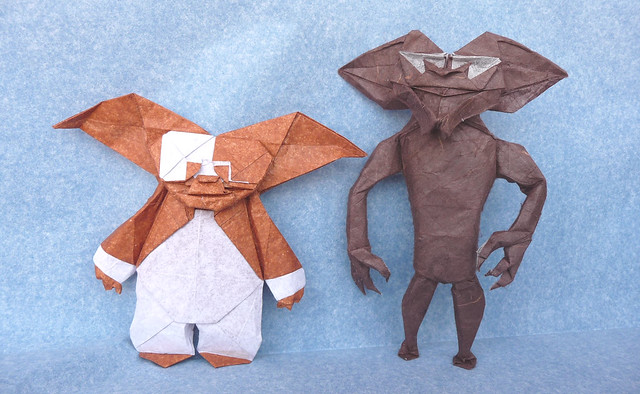This is actually from 2009- still relevant today:
A blogsite not for me to bloviate; but for me to share my origami videos with the origami community. I am affiliated with the Westcoast Origami Guild, Pacific Ocean Paperfolders, Origami Paperfolders of San Diego, Origami USA, and the Origami Interest Group (Origami-L/O-List).
Wednesday, August 28, 2013
Tuesday, August 27, 2013
Remember the movie "Gremlins"?
Another charming design(s) by Fernando Gilgado:
Mark Leonard's old site used to host diagrams for his Mogwai.
Sunday, August 25, 2013
Sunday Folding Funnies
Meet Ken Wong:
Since I often enjoy playing “devil’s advocate” in debates, I was among those who – although our very presence at that night’s reception made us obvious supporters of the webcomics movement - contrarily maintained there were still many things that print comics could do that webcomics could not. Our strongest argument in favor of printed comics was that they offered readers a physical/kinesthetic experience that webcomics could never duplicate; readers could bend, fold, tear or otherwise manipulate the comic in ways that are impossible to duplicate onscreen.At some point, it occurred to me that one could use origami, the Japanese art of paper folding, to create a comic in which the reader’s physical interaction with the comic as a tangible three-dimensional object was essential to the experience and, therefore, impossible to do as a webcomic.When I returned home, I decided to put theory into practice and the result was Pandora’s Box, a comic which readers must open and unfold (and, ideally, refold) as part of the reading experience. Crucially, the box is to be opened at precisely that point in the story when such an action is loaded with the greatest significance.I debuted Pandora's Box to a warm reception at the 2008 MoCCA Art Festival and have since gone on to create several other Origami Comics: Schrodinger's Cat; Flexagon!; 2d4; and Unsung.
Friday, August 23, 2013
Origami $ Piggy Bank
Love John Montroll's version. This one looks great, too:
The concept itself is a charming one.
The concept itself is a charming one.
Sunday, August 18, 2013
Wednesday, August 14, 2013
Origami's Future in Space Exploration
Hat tip to WCOG member, Helen Sperber:
A senior at South El Monte High School, and founder of its Engineering Club, Hua, 17, landed a coveted high school summer internship at JPL alongside about eight other high school students, where he joined the research of the deployment of solar arrays that utilize the basic principles of origami — a Japanese art form that creates flashy designs like birds, flowers and cartoon characters by folding a piece of paper.
“The way it folds up is very unique compared to other arrays where it’s just a square piece that folds up,” he said. “So there’s definitely some art in there.”
~~~
“They’re very aesthetic in their appearance in the way they fold, much like other origami,” said Brian Trease, a mechanical engineer at JPL and Hua’s mentor during his internship. “We cut it into pieces and reassembled in a certain way. Origami has ways. We’re allowed to break the rules for engineering purposes.”
The origami-inspired solar arrays use a rigid structure to safely fold into itself, keeping the array’s 90 individual solar cells sturdy.
“Fragile things like solar cells, which could just break when they’re bent, would be perfect for this solar array,” Hua said.
He said the design could also be applied in other applications.
Shrinking instruments to make for more room is a goal for current and future space exploration, according to Randall Foehner, a JPL mechanical engineer and the group supervisor of Hua’s internship group, division 38, which focused on mechanical deployables, actuators and booms.
“We’re trying to do more science with less spacecraft, so we’re miniaturizing everything,” Foehner said. “This technology, folding and storing in small volumes, is in perfect alignment with the future of a spacecraft and what we’re trying to do.”
Tuesday, August 13, 2013
Sunday, August 11, 2013
Saturday, August 10, 2013
Thursday, August 08, 2013
1st Sunday at Marti's- August 4, 2013
Marti was out of country; but her 1st Sunday of the month meeting was still hosted at her house.
Joe Hamamoto decided to show his face (since Beverly's 1st Thursday meeting was cancelled- a closer commute for him).
Yami was graced by the presence of his daughter, in town for a visit.
Another good turnout of friends, family, food, and folding fun.
 |
| Photo and folded Sok models by Allison Reisel |
Photos here
Sunday, August 04, 2013
Saturday, August 03, 2013
Saturday Morning Cartoons- Origami Warriors
I inquired about this series in a previous post, 5 years ago. Based on a Taiwanese comic book by Jhou Sian Zong :
This is so bizarrely bad...it's awesome. Like an origami nerd's dream...
An animated television series based on the comic book was produced by Dong Woo Animation and debuted in Taiwan in 2004. It aired in Japan on TV Tokyo in 2005; and in 2006, it became the first Taiwanese cartoon shown on South Korean television when it premiered on SBS. The staff include animators from Hong Kong, Japan and South Korea. Beside borrowing the idea of origami from the comic series, the story and characters of the animation series are greatly altered. Instead of combine with their Genies to became Origami Warriors, the characters simply summon their Genies. Also, instead of the adventures and the results of world war in the original series, the characters are all competitors of the "Origami Combat Competition".
This is so bizarrely bad...it's awesome. Like an origami nerd's dream...
Subscribe to:
Comments (Atom)







